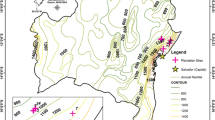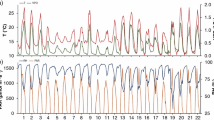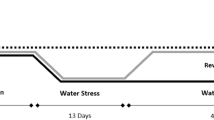Abstract
With the expansion of eucalyptus crops to areas with severe water limitations, physiological studies involving eucalyptus clones to identify those that are tolerant to water stress become important. The objective of this study was to assess morphological and physiological responses by eucalyptus clones subjected to drought stress and rehydration. The experiment consisted of three eucalyptus clones: VC865, I224 and I144 and two water regimes: control and water stress followed by rehydration, with six replicates. Leaf water potential, gas exchange, maximum quantum efficiency of photosystem II and plant height and stem diameter were evaluated under drought stress and rehydration. After 6 d of rehydration, the number of leaves, leaf area and dry mass of root, leaf, stem and their total were evaluated. All clones showed intense reduction of gas exchange during the drought stress period, and only VC865 and I144 showed rapid recovery with 3 d of rehydration. Clone I224 showed greater reduction in height, stem diameter, number of leaves, water potential at midday (Ψw Midday), and maximum quantum efficiency of photosystem II (Fv/Fm). Clones VC865 and I144 showed lower reductions in Ψw Midday and Fv/Fm under stress. VC865 had lower reductions in leaf number, leaf area and higher leaf dry mass, while clone I144 had higher height and lower reduction in root dry mass under. Both these clones showed higher water use efficiency with 3 d of rehydration. These different phenotypic plasticities gave the clones VC865 and I144 efficient mechanisms of acclimatization to stress and more drought tolerance, enhancing their greater capacity for recovery after stress, which allowed lower dry mass reduction. Clone I224, however, was more susceptible to drought stress, undergoing greater physiological damage with only partial recovery during rehydration.







Similar content being viewed by others
References
Amrutha S, Muneera PAB, Muthupandi M, Sivakumar V, Nautiyal R, Dasgupta MG (2019) Variation in morpho-physiological, biochemical and molecular responses of two Eucalyptus species under short-term water stress. Acta Bot Croat 78(2):125–134. https://doi.org/10.2478/botcro-2019-0021
Chen X, Zhao P, Ouyang L, Zhu L, Ni G, Schäfer KV (2020) Whole-plant water hydraulic integrity to predict drought-induced Eucalyptus urophylla mortality under drought stress. For Ecol Manag 468:118179. https://doi.org/10.1016/j.foreco.2020.118179
R CORE TEAM (2015) A language and environment for statistical computing. R. Foundation for Statistical Computing, Vienna, Austria. Available from: http://www.R-project.org/. Accessed 25 June 2021
Correia B, Pintó-Marijuan M, Neves L, Brossa R, Dias MC, Costa A, Araújo C, Santos C, Chaves MM, Pinto G (2014) Water stress and recovery in the performance of two Eucalyptus globulus clones: physiological and biochemical profiles. Physiol Plant 150(4):580–592. https://doi.org/10.1111/ppl.12110
Correia B, Hancock RD, Amaral J, Cadenas AG, Valledor L, Pinto G (2018) Combined drought and heat activates protective responses in Eucalyptus globulus that are not activated when subjected to drought or heat stress alone. Front Plant Sci 9:819. https://doi.org/10.3389/fpls.2018.00819
Cruz CD, Regazzi AJ (1994) Modelos biométricos aplicados no melhoramento genético. ImprensaUniversitária UFV, Viçosa, p 390p
Endres L, Santos CM, Souza GV, Menossi M, Santos JCM (2018) Morphological changes recorded in different phenophases of sugarcane plants subjected to water stress in tropical field conditions. Aust J Crop Sci 12(7): 1041−1050. https://doi.org/10.3316/informit.881611792651534
Favreau B, Denis M, Ployet R, Mounet F, Peireira SH, Franceschini L, Laclau J-P, Labate C, Carrer H (2019) Distinct leaf transcriptomic response of water deficient Eucalyptus grandis submitted to potassium and sodium fertilization. PLoS ONE 14:1–30. https://doi.org/10.1371/journal.pone.0218528
Fernandes ET, Cairo PAR, Morais JLC (2013) Crescimento de clones de eucalipto sob deficiência hídrica. Enciclopédiabiosfera 9(17):870
Ferraz AC, Mola-Yudego B, Gonzalez-Olabarria JR, Scolforo JRS (2018) Thinning regimes and initial spacing for Eucalyptus plantations in Brazil. An Acad Bras Cienc 90:255–265. https://doi.org/10.1590/0001-3765201720150453
Ferreira DF (2011) Sisvar: a computer statistical analysis system. Ciênc Agrotec 35:1039–1042. https://doi.org/10.1590/S1413-70542011000600001
Frosi G, Harand W, Oliveira MTD, Pereira S, Cabral SP, Montenegro AADA, Santos MG (2017) Different physiological responses under drought stress result in different recovery abilities of two tropical woody evergreen species. Acta Bot Bras 31:153–160. https://doi.org/10.1590/0102-33062016abb0375
Hamed SB, Lefi E, Chaieb M (2022) Growth phenology of pistachio seedlings under water stress and rehydration conditions. J Plant Biol Crop Res 5(1):1060
Hayat U, Jilani MI, Rehman R, Nadeem F (2015) A review on Eucalyptus globulus: a new perspective in the rapeutics. Int J ChemBiochemSci 8:85–91
IBA 2020 IBA Relatório (2020) Indústria Brasileira de Árvores, Pöyry Consultoria em Gestão e Negócios Ltda., Brazil, pp. 66. Available from: https://iba.org/datafiles/publicacoes/relatorios/relatorio-iba-2020.pdf. Accessed 28 July 2001.
Kapoor D, Bhardwaj S, Landi M, Sharma A, Ramakrishnan M, Sharma A (2020) The impact of drought in plant metabolism: how to exploit tolerance mechanisms to increase crop production. Appl Sci 10(16):5692. https://doi.org/10.3390/app10165692
Kijowska-Oberc J, Staszak AM, Kamiński J, Ratajczak E (2020) Adaptation of forest trees to rapidly changing climate. Forests 11(2):123. https://doi.org/10.3390/f11020123
Larcher, W (2006) Ecofisiologia vegetal. Traducao: PRADO, C.H.B.A. Sao Carlos: Rima. 531p.
Marchiori PE, Machado EC, Sales CR, Espinoza-Núñe E, Magalhães Filho JR, Souza GM, Pires RCM, Ribeiro RV (2017) Physiological plasticity is important for maintaining sugarcane growth under water deficit. Front Plant Sci 8:2148. https://doi.org/10.3389/fpls.2017.02148
Maxwell MO, Johnson GN (2000) Chlorophyll fluorescence: a practical guide. J Exp Bot 51(345):659–668. https://doi.org/10.1093/jexbot/51.345.659
Müller C, Hodecker BER, de Barros NF, Merchant A (2020) A physiological approach for pre-selection of Eucalyptus clones resistant to drought. iForest 13(1):16–23. https://doi.org/10.3832/ifor3185-012
Murchie EH, Niyogi KK (2011) Manipulation of photoprotection to improve plant photosynthesis. Plant Physiol 155(1):86–92. https://doi.org/10.1104/pp.110.168831
Ocheltree TW, Nippert JB, Prasad PVV (2014) Stomatal responses to changes in vapor pressure déficit reflect tissue-specific differences in hydraulic conductance. Plant Cell Environ 37(1):132–139. https://doi.org/10.1111/pce.12137
Pereira MRR, Klar AE, Filho ALM, Rodrigues ACR, Silva MR (2018) Influência de diferentes condições de solo no desenvolvimento de plantas de Eucalyptus urograndis submetidas a déficit hídrico. Irriga 12(4):519–530. https://doi.org/10.15809/irriga.2007v12n4p519-530
Pita-Barbosa A, NairamBerh Barros F (2016) Boron as mitigator of drought damage in Eucalyptus: a genotype-dependent mechanism? Sci For 44(112):851–861. https://doi.org/10.18671/scifor.v44n112.07
Rehschuh R, Cecilia A, Zuber M, Faragó T, Baumbach T, Hartmann H et al (2020) Drought-induced xylem embolism limits the recovery of leaf gas exchange in scots pine. Plant Physiol 184(2):852–864. https://doi.org/10.1104/pp.20.00407
Romeet S, Rai KC, Anugrah T, Haripriya K, Manoj R, Priya K, Kavidayal H, Raturi M, Kainthola C, Barthwal S (2019) Differential responses in gas exchange variability, water use efficiency and chlorophyll content in Eucalyptus clones under drought stress. Indian for 145(5):459–466
Santos ICD, Almeida AAFD, Anhert D, Conceição ASD, Pirovani CP, Pires JL, Valle RR, Baligar VC (2014) Molecular, physiological and biochemical responses of Theobroma cacao L. genotypes to soil water deficit. PLoS One 9(12):e115746. https://doi.org/10.1371/journal.pone.0115746
Saravanan S (2018) Gas exchange characteristics and water use efficiency in Eucalyptus clones. J Stress Physiol Biochem 14:49–58
Silva PH, Campoe OC, Paula RC, Lee DJ (2016) Seedling growth and physiological responses of sixteen eucalypt taxa under controlled water regime. Forests 7(6):110. https://doi.org/10.3390/f7060110
Souden S, Ennajeh M, Ouledali S, Massoudi N, Cochard H, Khemira H (2020) Water relations, photosynthesis, xylem embolism and accumulation of carbohydrates and cyclitols in two Eucalyptus species (E. camaldulensis and E. torquata) subjected to dehydration-rehydration cycle. Trees 34(6):1439–1452. https://doi.org/10.1007/s00468-020-02016-4
Sytsma KJ, Renner SS (2019) “Myrtales” Encyclopedia Britannica. Available from: https://www.britannica.com/plant/Myrtales. Accessed 8 July 2021
Valadares J, Paula NF, Paula RC (2014) Physiological changes in eucalyptus hybrids under different irrigation regimes. Rev CiêncAgron 45:805–814
Valladares F, Chico JM, Aranda I, Balaguer L, Dizengremel P, Manrique E, Dreyer E (2002) The greater seedling high-light tolerance of Quercus robur over Fagus sylvatica is linked to a greater physiological plasticity. Trees 16(6):395–403. https://doi.org/10.1007/s00468-002-0184-4
Velikova V, Arena C, Izzo LG, Tsonev T, Koleva D, Tattini M, Roeva O, Maio A, Loreto F (2020) Functional and structural leaf plasticity determine photosynthetic performances during drought stress and recovery in two Platanus orientalis populations from contrasting habitats. Int J Mol Sci 21(11):3912. https://doi.org/10.3390/ijms21113912
Xiong S, Wang Y, Chen Y, Gao M, Zhao Y, Wu L (2022) Effects of drought stress and rehydration on physiological and biochemical properties of four oak species in China. Plants 11:679. https://doi.org/10.3390/plants11050679
Author information
Authors and Affiliations
Contributions
VMF, JCDAN and LE: Designed the study, contributed to revise the manuscript. JRDA: Designed and performed research, wrote and revised the manuscript. CMDSSDO Maia Júnior: Wrote the paper. AFDSS, VMDS and LTB: Carried out the experiments.
Corresponding author
Additional information
Publisher's Note
Springer Nature remains neutral with regard to jurisdictional claims in published maps and institutional affiliations.
Project funding: This study was supported by the FAPEAL-Foundation for Research Support of the State of Alagoas, Brazil.
The online version is available at https://link.springer.com.
Corresponding editor: Yu Lei.
Rights and permissions
Springer Nature or its licensor (e.g. a society or other partner) holds exclusive rights to this article under a publishing agreement with the author(s) or other rightsholder(s); author self-archiving of the accepted manuscript version of this article is solely governed by the terms of such publishing agreement and applicable law.
About this article
Cite this article
Ferreira, V.M., de Andrade, J.R., dos Santos, C.M. et al. Physiological plasticity in eucalyptus clones in the vegetative stage contributes to drought tolerance. J. For. Res. 34, 1549–1561 (2023). https://doi.org/10.1007/s11676-022-01571-5
Received:
Accepted:
Published:
Issue Date:
DOI: https://doi.org/10.1007/s11676-022-01571-5




